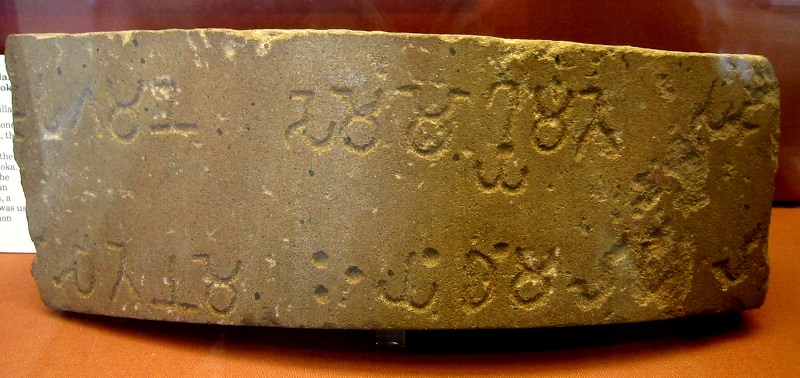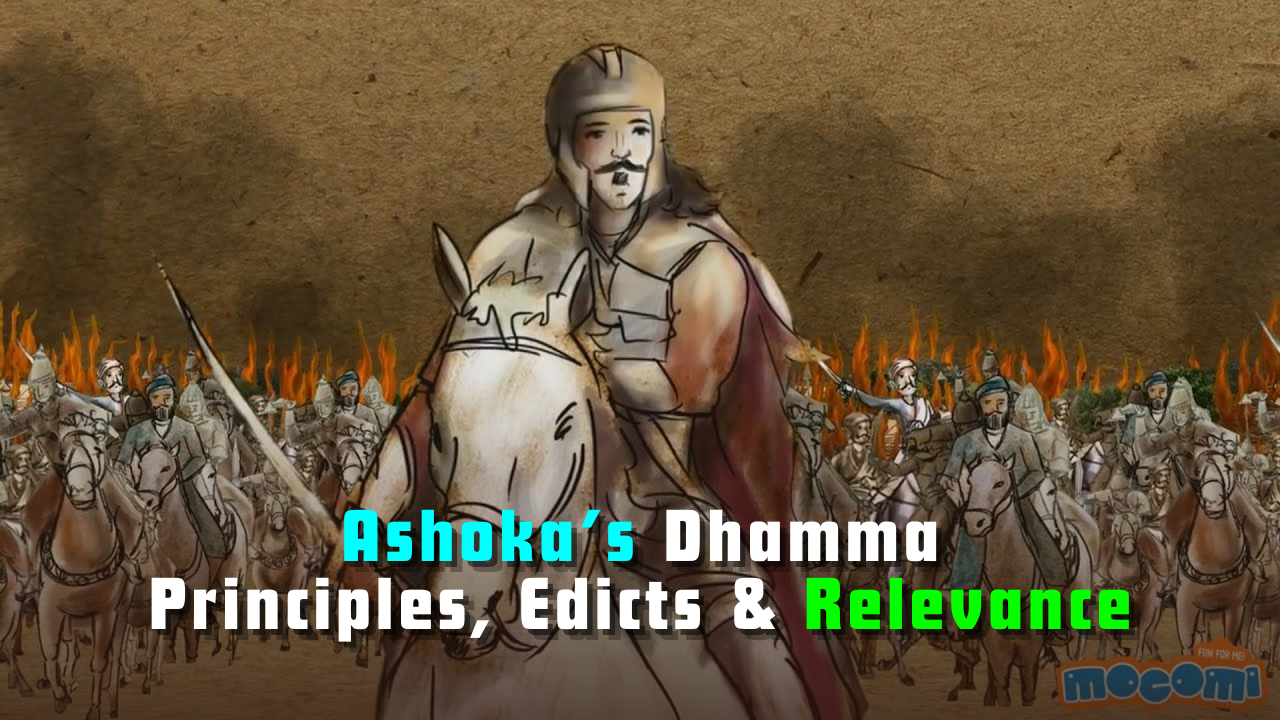Ashoka’s Dhamma: Principles, Edicts & Relevance
Understand Ashoka’s Dhamma and its role in unifying the Mauryan Empire through tolerance, non-violence, and moral governance. This comprehensive UPSC-oriented guide covers Major and Minor Rock Edicts, Pillar Inscriptions, Dhamma-Mahamattas, and its modern significance—essential for Prelims and GS Paper I (Ancient History).

Introduction: Ashoka’s Dhamma
Ashoka’s Dhamma is an important topic for the UPSC examination as it holds relevance for both Prelims and Mains. In Prelims, questions may directly test knowledge of Ashoka’s edicts, inscriptions, and the key principles of his Dhamma, which were propagated across his empire through Major and Minor Rock Edicts and Pillar Edicts. For Mains (GS Paper I), it is significant in understanding the cultural and political legacy of the Mauryan Empire, showcasing how Ashoka used a secular moral code to maintain unity and harmony in a diverse and vast empire.
Need for Dhamma
Ashoka’s Dhamma policy was developed to address the empire’s religious and cultural diversity, seeking to minimise conflicts and establish a shared ethical foundation that could unite people amid sectarian divisions. Chandragupta, his grandfather, clearly favoured Jainism, while his father, Bindusara, appeared to support the Ajivikas. Ashoka himself favoured Buddhism, but we should also be mindful of the wide range of spiritual practices across the Maurya dynasty.
Even within Buddhism, sectarian divisions were beginning to emerge, and orthodox Brahmanism itself was often at odds with the emergence of other heterodox movements like Buddhism, Jainism, and Ajivika thought. By introducing Dhamma, Ashoka acknowledged the necessity for some social cohesion without enforcing complete religious conformity through violence. Dhamma policy advocated for some respect for what others believe in and for peaceful co-existence. Maintaining some degree of political stability among the different caste and sectarian structures across an empire of this size was no mean feat.
Ashoka’s Dhamma was meant to put forward a moral principle rather than a sect, no matter where one sits. It is interesting that Ashoka preferred to implement Dhamma in order to ameliorate sectarianism and create an environment for people to remain faithful to their own traditions without becoming embroiled in violent conflict.

Principles of Dhamma
- The principles of Dhamma were designed to be acceptable to people from various communities and religious backgrounds. It did not have a rigid definition or structure but instead focused on promoting tolerance and ethical behaviour. Dhamma emphasised a dual form of tolerance—tolerance among individuals and acceptance of differing beliefs and viewpoints.
- It encouraged compassion toward slaves and servants, respect for elders, and generosity toward the needy, including Brahmanas and Sramanas. Emperor Ashoka strongly advocated for religious tolerance to foster a sense of unity and harmony among different sects.
- A key aspect of Dhamma was non-violence. This was not only about renouncing war and conquest but also involved discouraging the killing of animals. However, Ashoka recognised that maintaining order among the more primitive forest tribes might require some display of power.
- The Dhamma policy also included social welfare initiatives, such as planting trees and digging wells. Asoka criticised the ritualistic ceremonies and sacrifices performed on various occasions, considering them to be meaningless.
- To promote and implement these principles, Ashoka appointed a special group of officers called the Dhamma Mahamattas. They were tasked with spreading the message of Dhamma across society. Over time, however, these officers gained significant authority and began to function almost like a priestly class, eventually involving themselves in political matters as well.
Major Rock Edicts
- Major Rock Edict I prohibits animal sacrifices and discourages festive gatherings involving killing, reflecting Ashoka’s emphasis on non-violence and compassion.
- Major Rock Edict II highlights welfare measures as part of Dhamma. It mentions medical treatment for both humans and animals, as well as the construction of roads, wells, and the planting of trees.
- Major Rock Edict III promotes moral values such as generosity towards Brahmanas and Sramanas and respect for parents, qualities considered essential to righteous living.
- Major Rock Edict IV is a significant declaration of the Dhamma policy. It states that as a result of Dhamma, immoral conduct, disrespect towards religious figures, violence, and inappropriate behavior towards family and others had diminished. It also notes a considerable decline in animal slaughter.
- Major Rock Edict V records the first appointment of Dhamma-mahamattas in the twelfth year of Asoka’s reign. These officers were tasked with looking after the welfare of all religious sects and spreading the teachings of Dhamma across society. They were given key responsibilities in implementing the emperor’s policy.
- Major Rock Edict VI contains instructions to the Dhamma-mahamattas, granting them direct access to the emperor at any time, regardless of his engagements. It also emphasises the need for efficient administration and swift decision-making.
- Major Rock Edict VII appeals for religious tolerance. The edict suggests that sectarian tensions were high and aims to reduce conflict by promoting mutual respect and harmony.
- Major Rock Edict VIII marks a shift in royal activity. Ashoka replaced his earlier hunting expeditions with Dhammayatras (pilgrimages of Dhamma), which allowed him to meet and interact with people from different parts of the empire, further promoting Dhamma.
- Major Rock Edict IX criticises traditional ceremonies associated with birth, illness, marriage, and travel, particularly those conducted by women. Ashoka argues that these rituals are meaningless and instead advocates for the ethical practice of Dhamma.
- Major Rock Edict X rejects the pursuit of fame and glory, reaffirming that true merit lies in living according to the principles of Dhamma.
- Major Rock Edict XI provides further insights into Dhamma, emphasising respect for elders, kindness toward friends, and abstention from animal killing.
- Major Rock Edict XII once again appeals for religious tolerance. It reflects Asoka’s concern about sectarian strife and reinforces his call for peaceful coexistence.
- Major Rock Edict XIII is perhaps the most critical statement of Asoka’s Dhamma policy. It advocates for conquest through Dhamma rather than war. This represents the culmination of ideas introduced in earlier edicts, suggesting that true victory lies not in territorial expansion but in the acceptance and practice of Dhamma by people across different lands.

Minor Rock Edicts
The Minor Rock Edicts represent the earliest inscriptions issued by Emperor Ashoka, preceding the Major Rock Edicts in chronology. Among these, the Kandahar Bilingual Rock Edict—written in Greek and Aramaic—is notable as the first known inscription attributed to Ashoka.
These edicts have been discovered at various sites, including:Bahapur, Gujjara, Udegolam, Maski, Nittur, Siddapur, Brahmagiri, Jatinga Rameshwara, Rajula Mandagiri, Yerragudi, Sasaram, Bairat, and Ahraura, among others.
Out of all these sites, only four explicitly mention Ashoka by name:
- Maski
- Brahmagiri
- Nettur
- Gujjara
Major Pillar Edicts
The Major Pillar Edicts, comprising a set of seven inscriptions, are regarded as the most detailed and technically refined of all Ashoka’s proclamations. These edicts reflect the maturity of Ashoka’s moral and administrative thinking, having been composed toward the later part of his reign. While the majority of these inscriptions are located across the Gangetic plains, two fragmentary edicts discovered in Afghanistan stand out as exceptions. In terms of language, the edicts were primarily inscribed in Prakrit using the Brahmi script, which was standard for Ashokan inscriptions. However, the versions found in Afghanistan were written in Aramaic, adapted to the linguistic context of the region.
| Edict | Summary |
| Pillar Edict I | Outlines Ashoka’s commitment to the protection and welfare of his people. |
| Pillar Edict II | Describes the concept of Dhamma, emphasizing compassion, truthfulness, and virtue. |
| Pillar Edict III | Encourages citizens to curb violence, cruelty, anger, and envy. |
| Pillar Edict IV | Defines the roles and duties of Rajukas (district administrators). |
| Pillar Edict V | Lists animals and birds that are to be protected or not killed on specific days. |
| Pillar Edict VI | Discusses the emperor’s Dhamma policy and its application. |
| Pillar Edict VII | Promotes self-discipline and mental purity across all religious sects. |
Minor Pillar Edicts
The Minor Pillar Edicts are found entirely within the Gangetic plains, situated near the former Mauryan capital. These inscriptions appear exclusively on certain Ashokan pillars located at Sarnath, Sanchi, Kausambi, Rummindei, and Nigali Sagar. In terms of chronology, they were inscribed after the Minor Rock Edicts and are believed to have been produced alongside the Major Rock Edicts. All of these edicts were composed in the Prakrit language and engraved using the Brahmi script.
Propagation of Dhamma
Ashoka spread his Dhamma philosophy across the empire by means of an inventive communication method, centred around strategically inscribed edicts. These proclamations, inscribed on natural rock faces and specially erected pillars, were strategically positioned in high-traffic areas to maximise their visibility and impact. The emperor tailored his messages differently for various audiences – while most edicts addressed the general population, some were specifically directed toward the Buddhist monastic community, demonstrating Ashoka’s nuanced approach to governance and spiritual leadership. Certain inscriptions skilfully incorporated references to well-known Buddhist texts, making the Dhamma principles more accessible to devotees. The elaborate system of Major and Minor Rock Edicts, combined with the unique Pillar Edicts, created a widespread public communication network that crossed linguistic and regional divides. This sophisticated propaganda apparatus not only disseminated ethical teachings but also represented one of history’s earliest attempts at large-scale ideological dissemination, effectively transforming stone into a medium for moral instruction and imperial policy.
Significance in the Modern Era
In today’s world, Ashoka’s Dhamma remains profoundly significant, possibly more so than in the 3rd century BCE, as it delivers ethical answers to current global dilemmas. In an era plagued by global violence, the principle of Ahimsa (non-violence in action, speech, and thought) provides a moral framework to curb senseless bloodshed. Likewise, widespread cruelty toward animals highlights the need for virtues like Daya (compassion) and Karuna (mercy), which emphasise reverence for all living beings. Amidst religious and sectarian strife, the ideals of Sarva Dharma Sambhava (respect for all faiths) and Brahashruti (tolerance) can foster harmony, while Dhamma Vijay (victory through righteousness) offers a path for resolving international conflicts through cultural dialogue.
In governance, honesty fosters transparency and accountability, while the idea of paternal kingship encourages ethical leadership to counter corruption and nepotism. On a personal level, Sanyam (self-discipline) and Bhavashuddhi (purity of thought) cultivate moral strength, while Kritagyata (gratitude) and Apichiti (reverence) reinforce family bonds and societal values. In a world grappling with violence, corruption, and moral decay, Ashoka’s Dhamma stands as a timeless guide for building a just, compassionate, and harmonious society.
Subscribe to our Youtube Channel for more Valuable Content – TheStudyias
Download the App to Subscribe to our Courses – Thestudyias
The Source’s Authority and Ownership of the Article is Claimed By THE STUDY IAS BY MANIKANT SINGH



